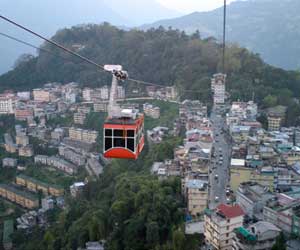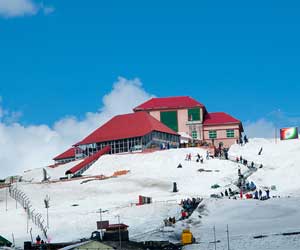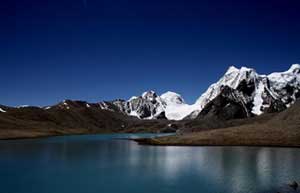Major Places of Interest in Sikkim
Sikkim :
Since the area of Sikkim ranges from the tropical to the alpine, the flora and fauna is unique in its diversity nowhere also on earth does such a small area comprise of so many species and verities. Even the seemingly Himalayan desert landscape in the North has a plethora of wild ducks and wild asses that room the plains. The natural wealth of Sikkim has been surveyed in detail by, among others, Dr.J.D.Hooker in the mid 20th century and more recently by the celebrated ornithologist of India, Dr.Salim Ali, who was also known as the "'Birdman"'. Other delightful species include the emerald Dove, woodpeckers, cuckoos, Kingfisher, & the fairy blue bird. Sikkim also has more than 600 species Butterflies many of them rare and endangered.
|
 |
| |
Gangtok :
Wreathed in clouds, Gangtok, the capital city of Sikkim is located on a ridge at a height of 5500 feet. With a spectacular view of the Khangchendzonga, the town provides the perfect base for travel through the state. Once an important transit point for traders traveling between Tibet and India, it is today a busy administrative and business centre and presents an interesting mix of cultures and communities. Gangtok is a cosmopolitan town which offers the tourist all possible amenities. Hotels are available in a range of prices along with a variety of eateries serving cuisine for all tastes. Shopping complexes, cyber cafes, night clubs and pool parlours abound for those so inclined. M. G. Marg is also the venue for the annual Gangtok Food and Culture festival held in December each year when Sikkims multi-cultural cuisine, along with music and dance performances are showcased. This event attracts a large number of locals and tourists each year.
|
 |
| |
Enchey Monastery :
Enchey Monastery an important seat of the Nyingmapa order, this 200 year old Enchey Monastery is built on the site blessed by Lama Drupto Karpo, a tantric master known for his power of flying.. Every year, around January, 'CHAM' or religious masked dance is performed with great fanfare for two days.
|
 |
| |
Flower Show :
Flower exhibitions are organized around the year at the Flower Show Venue near the White Memorial Hall Complex, Gangtok.
|
 |
| |
Dodrul Chorten :
The Dodrul Chorten or stupa was built by the Venerable Trullshi Rinpoche, head of the Nyimapa order of Tibetan Buddhism, in 1945. inside the Stupa, there is a complete mandala set of Dorji Phurba ( Vajra Kilaya), a set of Kangur relics ( Holy Books ), Complete Zung ( mantras) and other religious objects. Around the chorten, which is one of the most important Stupas in Sikkim, are 108 Mani Lhakor (Prayer wheels).
|
 |
| |
Handloom and Handicrafts Centre :
It is now known as the Directorate of Handicrafts and Handlooms as well as the Government Institute of Cottage Industries. Started during the time of the Chogyals of Sikkim, as a venture to protect and propagate the craft and skills of local and village artisans, it has become one of the major attractions for people visiting Gangtok where traditional handcrafts, furniture, handlooms carpets and other products can be viewed and also purchased.
|
 |
| |
Namgyal Research Institute of Tibetology (NRIT) :
The Namgyal Institute of Tibetology, after the late Chogyal of Sikkim, Palden Thondup Namgyal whose brainchild it was has since become one of the most prestigious depository of Tibetan literature, rare manuscripts, paintings, thangkas, statues and religious objects and other works of art and history. Today, it is a renowned worldwide centre for study of Buddhist philosophy and religion.
|
 |
| |
Tsongo Lake :
It literally means the "'source of the Lake"' in the Bhutia language. Just about 40km away from Gangtok, the capital of State, on the Gangtok Nathula route. This serene lake is situated at an altitude of 3,780 mtrs / 12,310 feet. The lake is about 1 km long, oval in shape, 15mtrs deep and is considered sacred by the local people. This placid lake remains frozen during the winter months upto mid-May. Between May and August, it is possible to see a variety of flowers bloom, including the rhododendrons, various species of primulas, blue and yellow poppies, iris, etc. It is also an ideal habitat of the Red Panda and various species of birds. The visitors have to get the permit to visit the place by applying to the Tourism Department through a registered Travel Agency.
|
 |
| |
Nathula :
56 kms from Gangtok is a 'Nathula' Pass at an altitude of 14,200 ft. bordering between India and China in the Tibetan Plateau. It is one of the highest motor able roads and richly covered by many verities of alpine flora and fauna. A tranquil place to visit. Trip to Nathula is closed on Mondays and Tuesdays. The visitors have to get the permit to visit the place by applying to the Tourism Department through a registered Travel Agency. Nathula pass was a major corridor of passage between India and Tibet before it was closed in 1962. Located at around 64 kms from Gangtok the road to Nathula passes through the Tsongo Lake. On a clear day, you can even see the road winding down the Chumbi valley. Tourists are allowed to go close to the international border from where one can see the Chinese soldiers on the other side of the barbed wire. One can find the ATM facility here which is world's highest Automated Teller Machine.
|
 |
| |
Tashi View Point :
Situated along the Noth Sikkim Highway, it is only 8kms from Gangtok. From this point you get a breathtaking view of Mt. Kang-chen-Dzongaand Mt. Siniolchu, one of the most graceful peaks in the world. Ideal time to visit is early in the morning.
|
 |
| |
Ranka Monastery / Lingdum :
Monastery in Sikkim has its unique signature / aura about it. This monastery is also known as the Lingdum Monastery. This is a fairly peaceful place and hence one can spend more time photographing or simply going around the place. There is a long line of prayer wheels just near the entrance. It is customery spinning these prayer wheels. Before the Tibetian New Year one can find the young Buddhist monks practising the Lama dance. It has a distinct style and form and is quite enjoyable just to see them training. There is steep flight of stairs which leads guest to the inner sanctum. It is better to visit this place during prayer.
Hymns are sung with various musical instruments used along with the traditional Buddhist gong. The sound and the silence both are appealing. Young monks conducts the evening prayer session. The inside of the monastery has colourful wall hangings touching nearly all the way to the floor. The walls as usual have depictions and drawings all around. The inner sanctum of the Lingdum monastery is very much like any other large monastery. Large sized Buddha statues plated in gold could be seen. The best part of this monastery is its access. This monastery is open to tourists and one can happily explore the entire perimeter.
|
 |
| |
Ban Jhakri Falls :
Ban Jhakri Falls has been for many years from now but has gained popularity very recently many operator still avoid this view point with other points due to its remoteness with other points. If added the one day sight seeing becomes very hectic. This is located on the route to Ranka Monastery and nearly 4 kilometers from Gangtok. Ban Jhakri Falls Energy Park lies amidst a lush green valley spread over nearly 2 acres and is quite nice and popular among tourist. It is surrounded by trees and gushing mountain stream. The Park has a Shamanistic theme. Hence, while the location of the park penetrating the forest spreads and seeks to enhance the essence of the occult and the unknown. The place itself is littered with ethnic sculptures and figurines of the Jhakri culture. We would advice our guest to visit five to six points and make the trip enjoyable rather than making it tiring.
|
 |
| |
Buddha Park of Ravangla :
Reminiscent of a town from the Wild West, Ravangla is a sleepy hamlet at a height of about 7000ft. The township comes alive during the pang Lhabsol festivities when the spectacular warrior Dance is performed at the Ravangla Monastery by the locals. The Buddha Park of Ravangla, also known as Tathagata Tsal, is situated near Rabong (Ravangla) in South Sikkim district, Sikkim, India. It was constructed in 2006-13 and features a 130-foot high statue of Lord Buddha as its centerpiece. The site was chosen within the larger religious complex of the Rabong Gompa (Monastery), itself a centuries-old place of pilgrimage. Also nearby is Ralang Monastery, a key monastery in Tibetan Buddhism.
|
 |
| |
Pelling :
Pelling is famous for the magnificent view of the snow-capped mountains of Khangchendzonga. It is located 125 km away from Gangtok at an altitude of 6,800 ft. On the way to Pelling, travellers come across the picture perfect scenery of woody hills, condescending clouds, snow, and rock formations. Pelling gives a spectacular views of the Mount Khangchendzonga.
|
 |
| |
White Water Rafting :
The white water of the Teesta & Rangit offers an experience not to be missed by the adventure enthusiast. The thrill of riding the wild rapids and the rush of adrenalin through your body is a feeling hard to duplicate. The roller coaster ride over the trotting white water of the Teesta will leave you breathless & hungry for more or if you want to pit your skills as a river rafter against the current try the more demanding Kayaking experience. Come & explore the daredevil in you. River rafting package programmers can be arranged through recognized tour operator during the tourist season customized packages can also be accommodated given prior notice.
|
 |
| |
North Sikkim - Yumthang Valley :
Yumthang, at an elevation of 11,800 ft. & 140 kms. from Gangtok, is a paradise for nature lovers with a fascinating blend of flora & fauna and breathtaking scenic grandeur. Yumthang "Tsa-Chu" or the hot spring on the left bank of Lachung Chu is immensely popular for its curative and healing power. Covered with rhododendron shrubs and trees, the entire valley erupts into a riot of colors in May. Lachung, a quaint village which has its own unique beauty and lifestyle. On the way to Lachung is Singhik where one can see the magnificient Kanchendzonga range in its splendour.
|
 |
| |
Gurudongmar Lake :
Gurudongmar lake, situated at a height of 17500ft., in the cold desert of Sikkim is so wonderful that it mesimerizes everybody. After travelling through lachen, lachung via nearly NO ROAD, when we cross army check post, lack of oxygen starts troubling weak people. As we proceed upwards with no metal road, scene reminds us den of GABBAR of sholay, but as soon we reach there on top, heaven appears to come in front of us from no where. When we enter in great Indian army's all religion temple and drink hot water there, all our tiredness disappears in seconds. When we look at beautiful green coloured lake with snowcaped mountain on one side and plant less hill on other side, we salute from our deep heart to almighty god for his wonderful creation, really heaven.
|
 |
|
|